MARIANI’S
Virtual
Gourmet
January 10,
2016
NEWSLETTER

Sean
Connery as James Bond in "Goldfinger" (1964)
IN THIS ISSUE
WHY DUBAI
Part Two
By John Mariani
NEW YORK CORNER
CHAZZ PALMINTERI
By John Mariani
NOTES FROM THE WINE CELLAR
CANTINA SANTA MARIA LA PALMA
By John Mariani
❖❖❖
WHY DUBAI
Part Two
By John Mariani

The photo above is not a model of the current city
of Dubai. It
is a model of the new city the ruling Al Maktoum
family—with numerous investors—plans to build
right next door, complete with the world’s largest
air-conditioned arcade and theme parks, all of it
to be ready before the 2020 Expo here.
Gigantism has become the norm in
this sprawling city, which ten years ago was barely
an encroachment on the desert that surrounds it.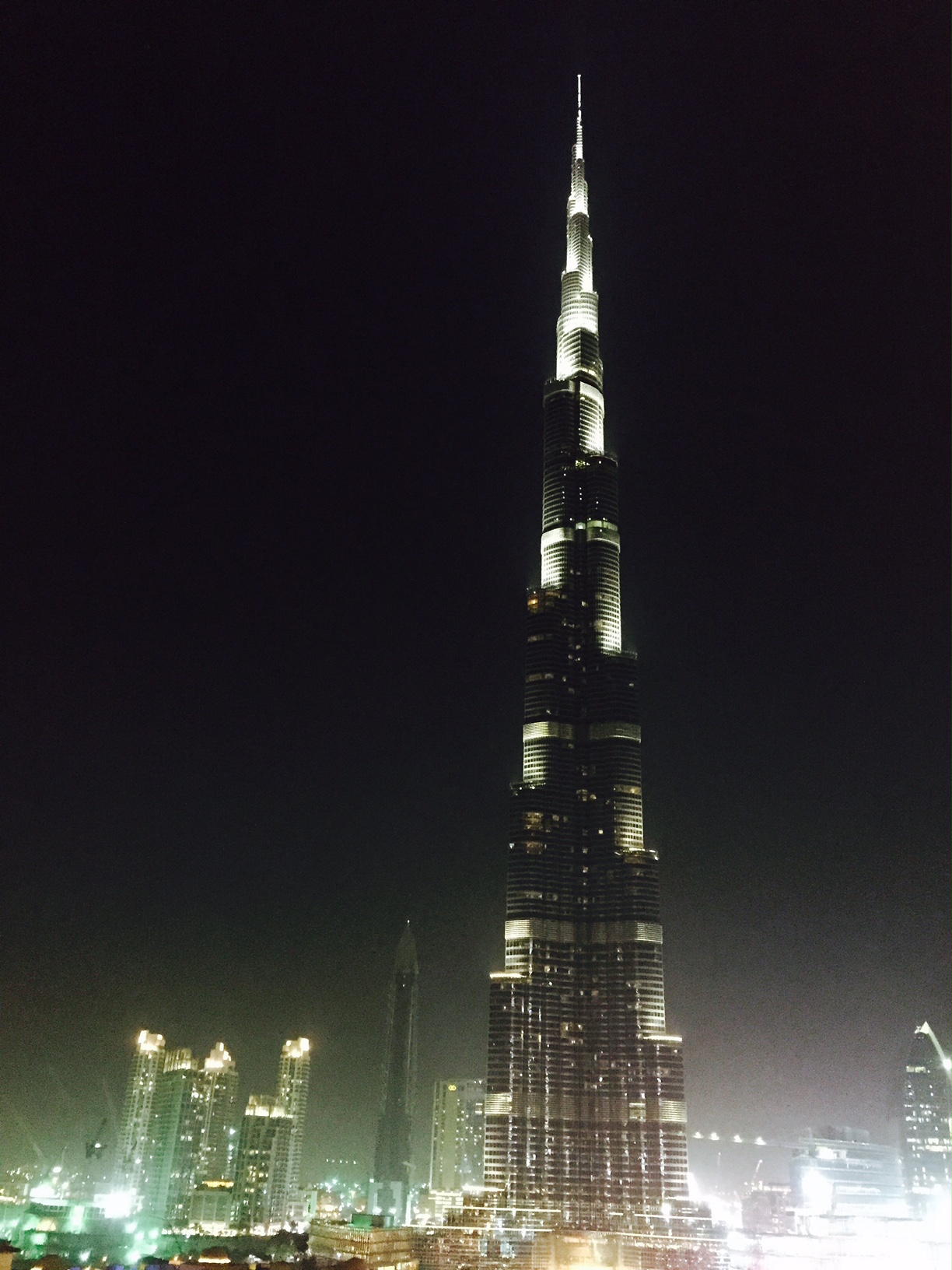 Driven
by international banking and commerce, and
increasing tourism largely from Asia, Dubai brags
about size, whether it’s the gargantuan Dubai Mall
(after London, having the largest collection of
retail brands), or the world’s tallest building, the
Burj
Khalifa (right),
at 160 floors and 2,716 feet (NYC’s Empire State
Building is a mere 1,250 feet and Taipei’s 101
Building a paltry 1,671).
Driven
by international banking and commerce, and
increasing tourism largely from Asia, Dubai brags
about size, whether it’s the gargantuan Dubai Mall
(after London, having the largest collection of
retail brands), or the world’s tallest building, the
Burj
Khalifa (right),
at 160 floors and 2,716 feet (NYC’s Empire State
Building is a mere 1,250 feet and Taipei’s 101
Building a paltry 1,671).
The breathtaking observation
floor—which is called The Top of the Burj Khalifa—is
actually on the 124th floor, only three-quarters of
the way to the pinnacle. Of course, Emiratis (the name
used for natives of Dubai) make curious boasts for
the skyscraper, noting the total amount of concrete
used equals the weight of 100,000 elephants, which
Dubai has none of, and enough steel used for the
frame to build five Airbus 380s, of which Emirates
Airlines has 65.
The Dubai
Fountain (below)—world’s
largest—shoots water up to 500 feet from Burj Dubai
Lake, with shows every 30 minutes. Dubai
even proclaims its Burj al-Aran to be the world’s
only “seven-star hotel,” though there is no such
international ranking. Then there are the Palm
Islands, the world’s largest man-made islands,
connected to the mainland by bridge and monorail.
 All
this
boasting smacks of Las Vegas-style ballyhoo, but,
unlike that other city in a desert, Dubai started
from scratch and hired the world’s top architects,
engineers and designers to fabricate everything from
the city’s buildings—Skidmore,
Owings and Merrill designed both the Burj Khalifa
and the Rolex Tower—to
street plans, always with a focus on
state-of-the-art energy savings; of course, Dubai
has the world’s largest collection of wind towers.
All
this
boasting smacks of Las Vegas-style ballyhoo, but,
unlike that other city in a desert, Dubai started
from scratch and hired the world’s top architects,
engineers and designers to fabricate everything from
the city’s buildings—Skidmore,
Owings and Merrill designed both the Burj Khalifa
and the Rolex Tower—to
street plans, always with a focus on
state-of-the-art energy savings; of course, Dubai
has the world’s largest collection of wind towers.
As for hotels, nearly every international
brand has a unit in Dubai, with dozens more coming
on line before the 2020 Expo, including three Hilton Worldwide hotels,
Melia Hotels International, Park Inn by Radisson,
and Starwood due to open soon. When I
visited last year I stayed at The Address, a very
luxurious and very well-run hotel near the mall and
Burj Khalifa, but, as everyone’s heard, it had a
massive fire on New Year’s Eve, so I withhold my
recommendation for the time being.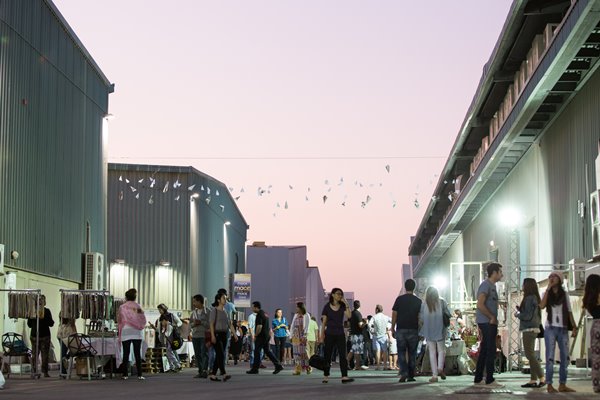
Dubai is well aware that high
culture is crucial for a city to earn an
international reputation for modernity and as a
tourist draw, but progress has been slow. The Dubai Museum offers a
good look at the area’s history, and music and
cinema festivals are now held throughout the year. One of
the most interesting developments I saw is Alserkal
Avenue (right),
a series of warehouses with more than 20 art
galleries featuring largely contemporary artists
from both in and outside the Emirates.
Dubai’s thrusting itself into the
21st century with such a high gloss has,
unfortunately, removed most of what once constituted
a historic culture, with old neighborhoods razed to
make way for the new.
The little that remains is in the Bastakiya
District, which, though not very extensive and
largely a reconstruction, shows how the town looked
in the 19th century, when it was a merchants’
neighborhood, now lined with galleries and
boutiques. Your
first stop here should be at the beautiful Sheikh Mohammed
Centre for Cultural Understanding (below)—the view from the rooftop
is requisite—then go on to the white gypsum
mosque, then just stroll through the section along
the Old City Wall, perhaps stopping at the Arabian
Tea House for refreshment.
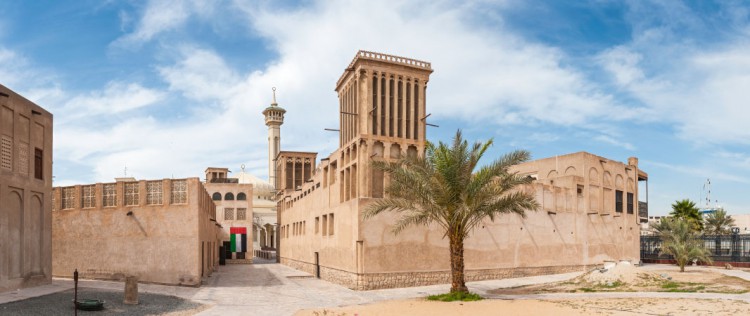 The
saltwater Dubai Creek, along which the Al Maktoum
dynasty was first established, divides the modern
city from the older, and crossing the Creek by
rickety water taxi brings you to the madly bustling
souks, which are known by their specialties: the
Gold Souk, Spice Souk, Perfume Souk, and the Old
Souk, particularly well known for its textiles.
Haggling—for some visitors a challenge, but for most
people agony—is encouraged at the souks, but the
seller will always win, no matter how glum he
appears after he’s dropped the price. Continue
down the creek and you’ll come to the peaceful Ras
Al Khor Wildlife Sanctuary, a wetlands preserve for
migratory birds.
The
saltwater Dubai Creek, along which the Al Maktoum
dynasty was first established, divides the modern
city from the older, and crossing the Creek by
rickety water taxi brings you to the madly bustling
souks, which are known by their specialties: the
Gold Souk, Spice Souk, Perfume Souk, and the Old
Souk, particularly well known for its textiles.
Haggling—for some visitors a challenge, but for most
people agony—is encouraged at the souks, but the
seller will always win, no matter how glum he
appears after he’s dropped the price. Continue
down the creek and you’ll come to the peaceful Ras
Al Khor Wildlife Sanctuary, a wetlands preserve for
migratory birds.
If you truly wish to see what the
Emirates were like a century ago, you can take a
wildlife drive into the desert, and have breakfast  at a
Bedouin’s home, sitting on carpets under a thatched
roof and enjoying an array of mezzes while
drinking tea or soda, as your white-robed host
speaks (by translator) with a candid lack of
nostalgia of how, in the new Dubai that grants him
his own farm and all modern amenities life has
become so much easier that he and his tribal members
have no desire to return to a nomadic way of life. “I now
have everything I need,” my host said, “even people
to take care of my farm and animals. There was
no romance in being a nomad. It was a very difficult
life.”
at a
Bedouin’s home, sitting on carpets under a thatched
roof and enjoying an array of mezzes while
drinking tea or soda, as your white-robed host
speaks (by translator) with a candid lack of
nostalgia of how, in the new Dubai that grants him
his own farm and all modern amenities life has
become so much easier that he and his tribal members
have no desire to return to a nomadic way of life. “I now
have everything I need,” my host said, “even people
to take care of my farm and animals. There was
no romance in being a nomad. It was a very difficult
life.”
Civilization—the
very word derives from the Latin word for city—has
throughout history been a double-edged sword that
cuts away the old ways while bringing new vitality
to a region.
In Dubai time does fly, and time will tell, as, in
Shelley's poem "Ozymandias": "Boundless and
bare/The lone and level sands stretch far away."
IF YOU
GO . . .
● Tickets to The
Top of the Burj Khalifa are timed and may be
bought in advance, for about $34.
● A good
way—though not cheap—to see the breadth of Dubai is
to fly over it on a tour from Seawings Seaplane.  Two different 40-minute tours
are offered at $461 and $516 per person.
Two different 40-minute tours
are offered at $461 and $516 per person.
● Beaches are
free, and there is a 9-mile seaside corniche ideal
for walking and jogging.
● Best time to
shop the malls is right when they open. The prices
at the downtown malls are often lower than at the
duty-free shops at the Dubai Airport.
● Tipping is not
expected but appreciated. Five dirhams ($1.35) for a
bellboy is fair; in restaurants there is a service
charge added to the bill.
● Cheapest way to
get around is to buy a Nol card at 14 dirhams
($3.80) for a day pass, for the metro, buses, water
buses and parking.
● If you become ill while in Dubai,
the city’s medical facilities, both public and
private, are considered to be of a very high
standard. Services
are not free to foreigners, however, so you may want
to consider international health insurance or check
with your provider.
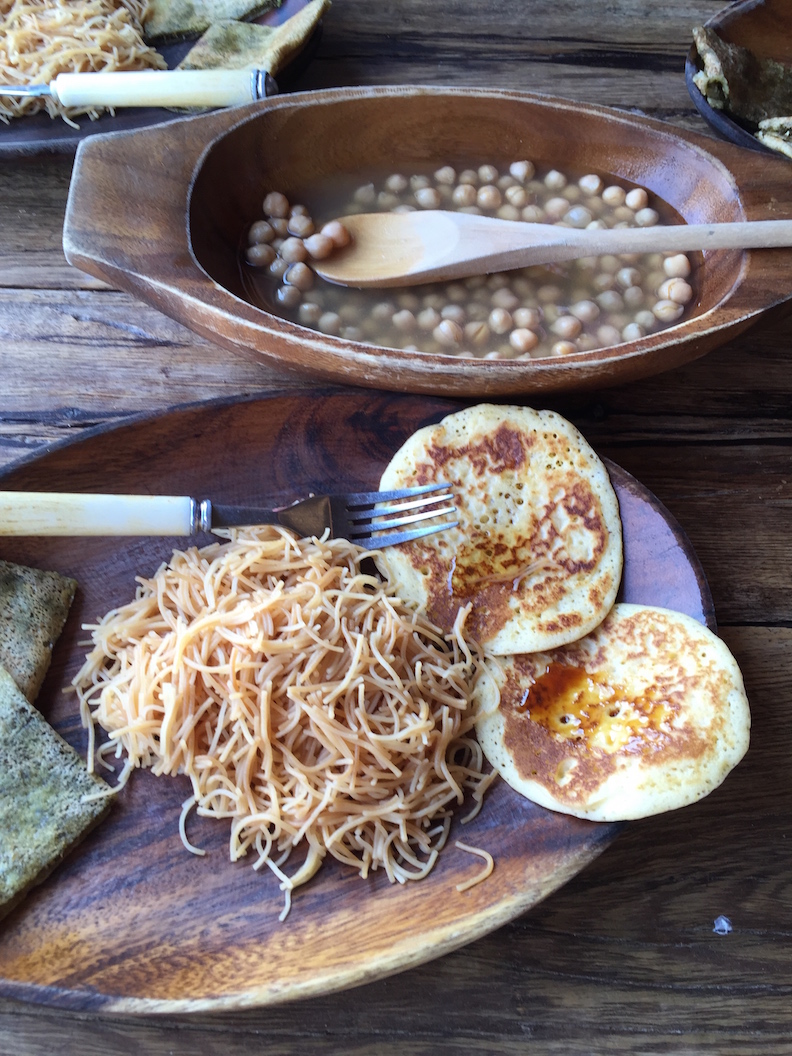
● Breakfast and wildlife safari (left) can be booked through Platinum Heritage Luxury Tours.
❖❖❖
By John Mariani
CHAZZ PALMINTERI
Ristorante Italiano
890 2nd Avenue (near 48th Street)
212-355-5540
chazzpalminterinyc.com

Back in the ‘70s a style
of Italian restaurant emerged in NYC that set
itself apart from the dated “red sauce”
restaurants with checkered tablecloths and
Chianti bottle candle holders. Not that stellar
Italian restaurants hadn’t existed—the elegant
Piemontese ristorante Barbetta opened in
1906—but these new, so-called “Northern Italian”
restaurants, like Il Nido, Il Menestrello and
Gianmarino, most of them on the East Side,
prepared pastas tableside by captains in
tuxedos. They had décor familiar to a clientele
familiar with the best restaurants in Rome,
Florence and Venice. None served pizza, which
was considered a trattoria item, not one found
in a true ristorante.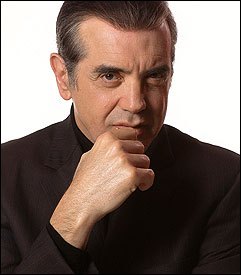
Sadly, many of those ristoranti disappeared;
some closed while others, like Il Mulino, were
corporatized and lost their individuality—just as
a new wave of downtown trattorias serving
“gourmet” pizzas began attracting an arts and
fashion crowd with their casual atmosphere, brick
walls, loud music, cramped quarters and witless
waiters in t-shirts with the restaurant’s name on
the front. On the West Side elegant new places
like Marea, A Voce and Lincoln Ristorante opened,
but were in a different style from those of the
1970s and 1980s.
Now, thanks to actor-director
Chazz Palminteri—in partnership with the Sinanaj
brothers, who also run Empire Steakhouse and Ben
& Jack’s Steakhouse—the brand new 140-seat
Chazz Palminteri Ristorante Italiano near Grand
Central Terminal restores much of the classic
look, food and service that has been missing for
the past decade.
The premises used to be a
pizzeria, but you’d never know it now. The décor
is sumptuous, graceful, in rich fabrics and colors
of Parma gold, with antique brown leather chairs,
red tiles, and of course thick tablecloths and
linens, with mirrors that open up the space still
more. The wine list is 250-label strong, along
with Chazz’s own brand of Sicilian BIVI 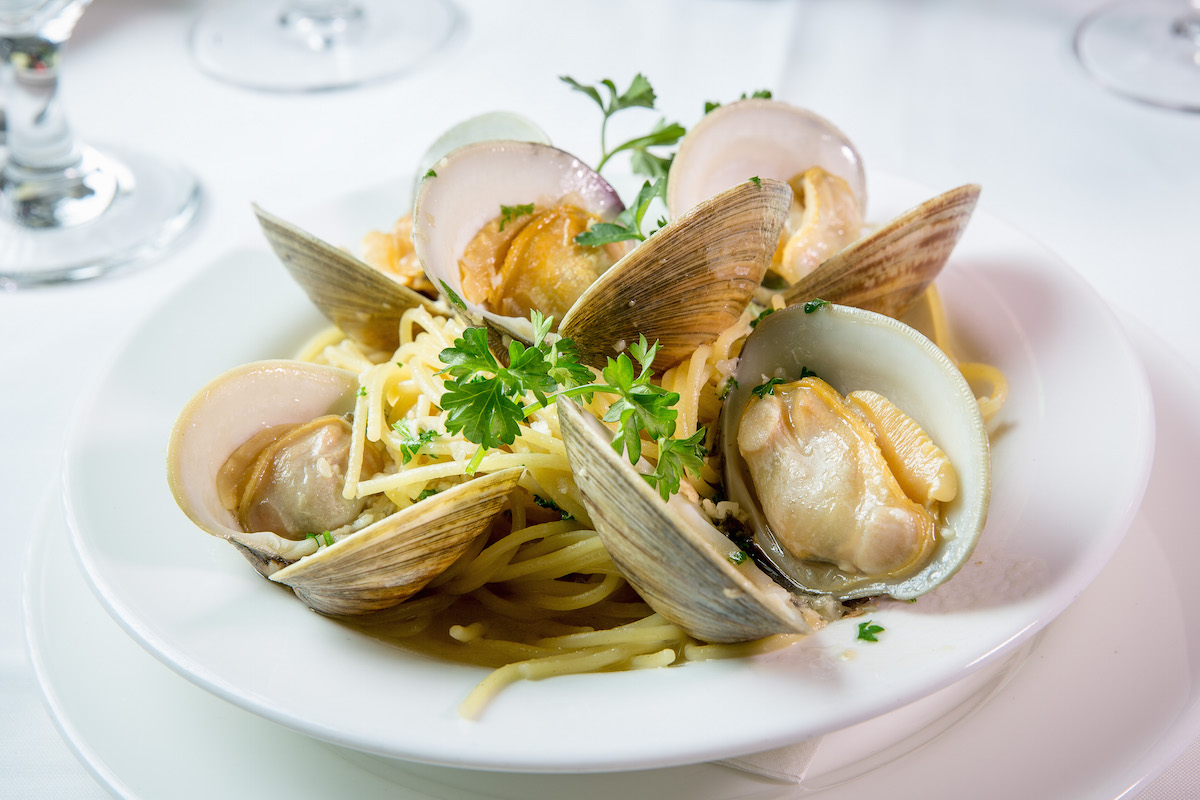 vodka. The maître d’ wears a
well-cut tuxedo.
vodka. The maître d’ wears a
well-cut tuxedo.
And
Chazz Palminteri is regularly on premises,
greeting old friends and new guests who know his
work from “A Bronx Tale” (which he wrote and
starred in) so well that they quote lines from it.
Abundance is a virtue here,
from large antipasti
platters and pasta to a true rack of baby lamb
and massive venison chop. And the most expensive
item on the menu (besides chateaubriand for two at
$84.95) is a USDA Prime ribeye at $44.95; that’s
almost a bargain these days.
We began
with antipasti
of roasted asparagus splashed with sherry and
generously topped with a gratin of Parmigiano
($12.95) and jumbo shrimp alla romana
($15.95) sautéed with chopped spicy peppers in a
light and very creamy Gorgonzola sauce served over
garlic bread. You could make a meal out of these.
All the pastas we tried were
very good, including ravioli with funghi
porcini glossed with a rich black truffle
sauce ($26.95). Potato gnocchi were excellent,
just the right plumpness, in a rich veal ragù with
shavings of Parmigiano ($23.95), and tender
housemade bucatini
alla carbonara with sweet onions and pancetta,
and mixed with an egg yolk, so it didn’t really
need the touch of cream ($20.95). Pastas
may be ordered as appetizer portions.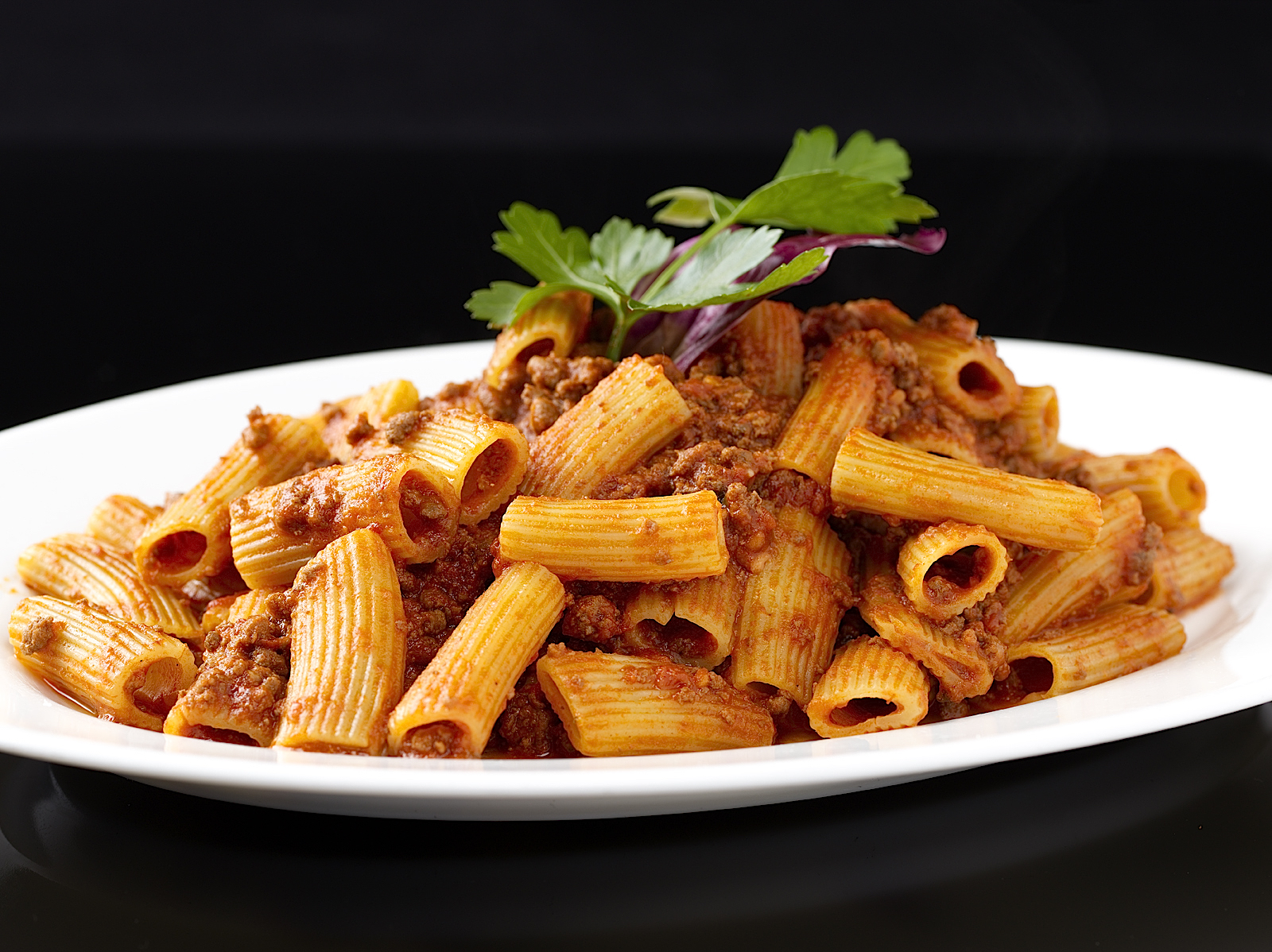
There is always a temptation to
go easy on the main courses after such rich
pastas, but you would be missing wonderful dishes
like Dover sole baked with fresh herbs and served
with a lemon caper sauce (market price). A
hearty, country-style dish is the chicken alla
scarpariello with sweet garlic, hot cherry
peppers, sprinkled with rosemary and cooked in a
white wine sauce, a lavish dish for just $26.95.
You will find a veal chop on
every Italian menu in NYC but not a rack of veal
(market price), as served here, topped with
sautéed onions, mushrooms, peppers, fresh herbs
and served with roasted potatoes. Unless
you share this dish, you’ll probably take a lot
home. The same goes for a juicy rack of American
lamb (market price) served in a well-reduced mint
sauce. And the special the night I dined there was
the first good venison chop I’ve had this winter,
meaty, mildly gamey, in a well-seasoned wine-dark
sauce.
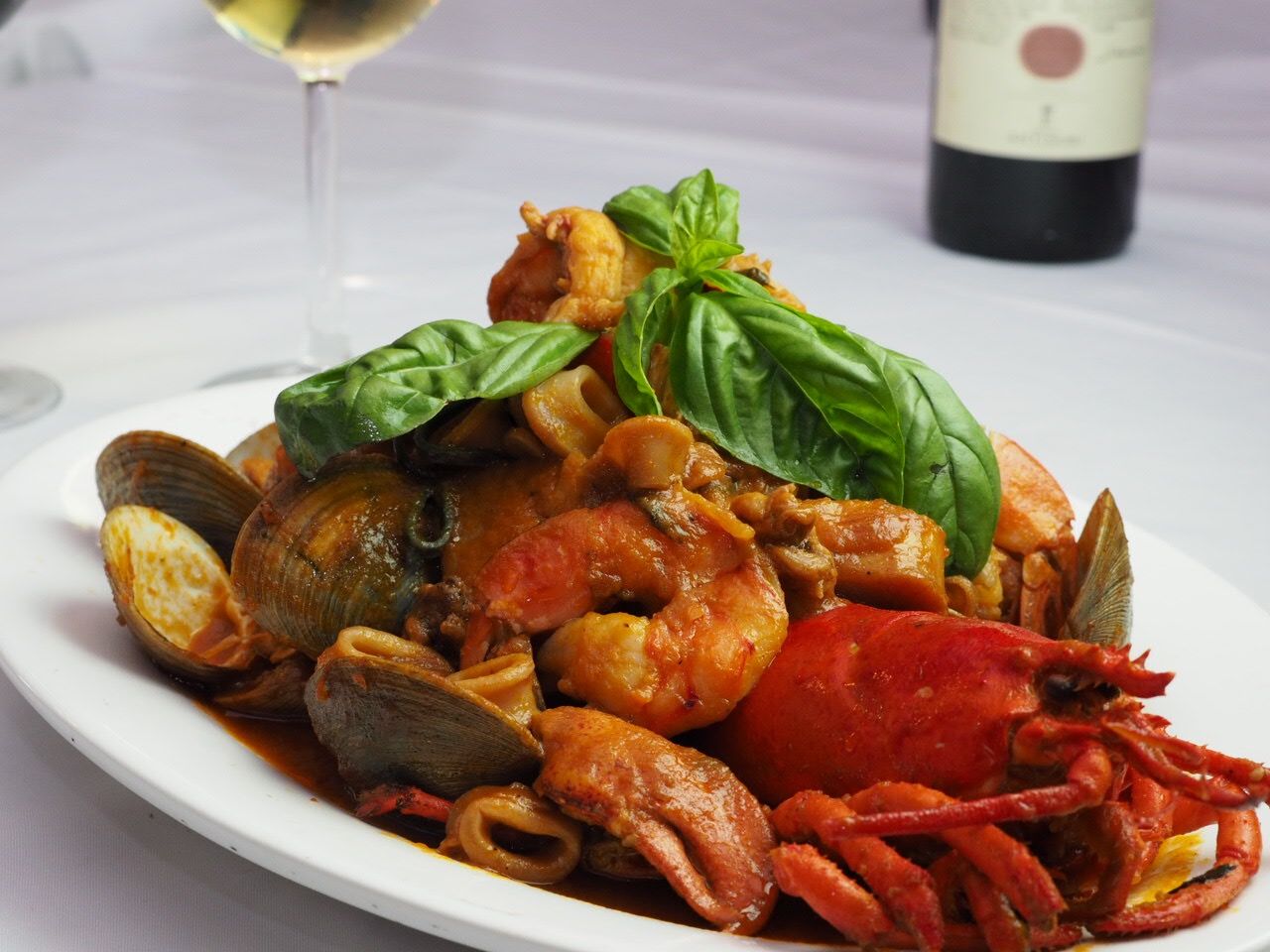 If you feel
you need to, share a slice of good cheesecake at
the end.
If you feel
you need to, share a slice of good cheesecake at
the end.
Celebrity-partnered
restaurants rarely have little more than a name on
the door, with very little input from the celeb,
who may or may not know anything about the food
served. At
Chazz Palminteri you are guaranteed two things:
that the Sinanaj brothers are the pros behind the
restaurant, purchasing high-quality ingredients
and maintaining an Old World service style, and
that Chazz Palminteri has his own vision of what a
restaurant with his name on it should be and he’s
not about to let that change.
Open for lunch and dinner daily; fixed price
lunch at $25.95.
❖❖❖
SARDINIAN WINES INTO THE 21ST CENTURY
By John Mariani

At one
o’clock in the afternoon on a December day in
Alghero, Sardinia, I was staving off jet lag in
the most sensible way: eating tiny shrimp,
mussels, razor clams, calamari and fried moray
eel in La Boqueria, the city’s fish market,
while drinking a sparkling Vermentino di
Sardegna called Akènta.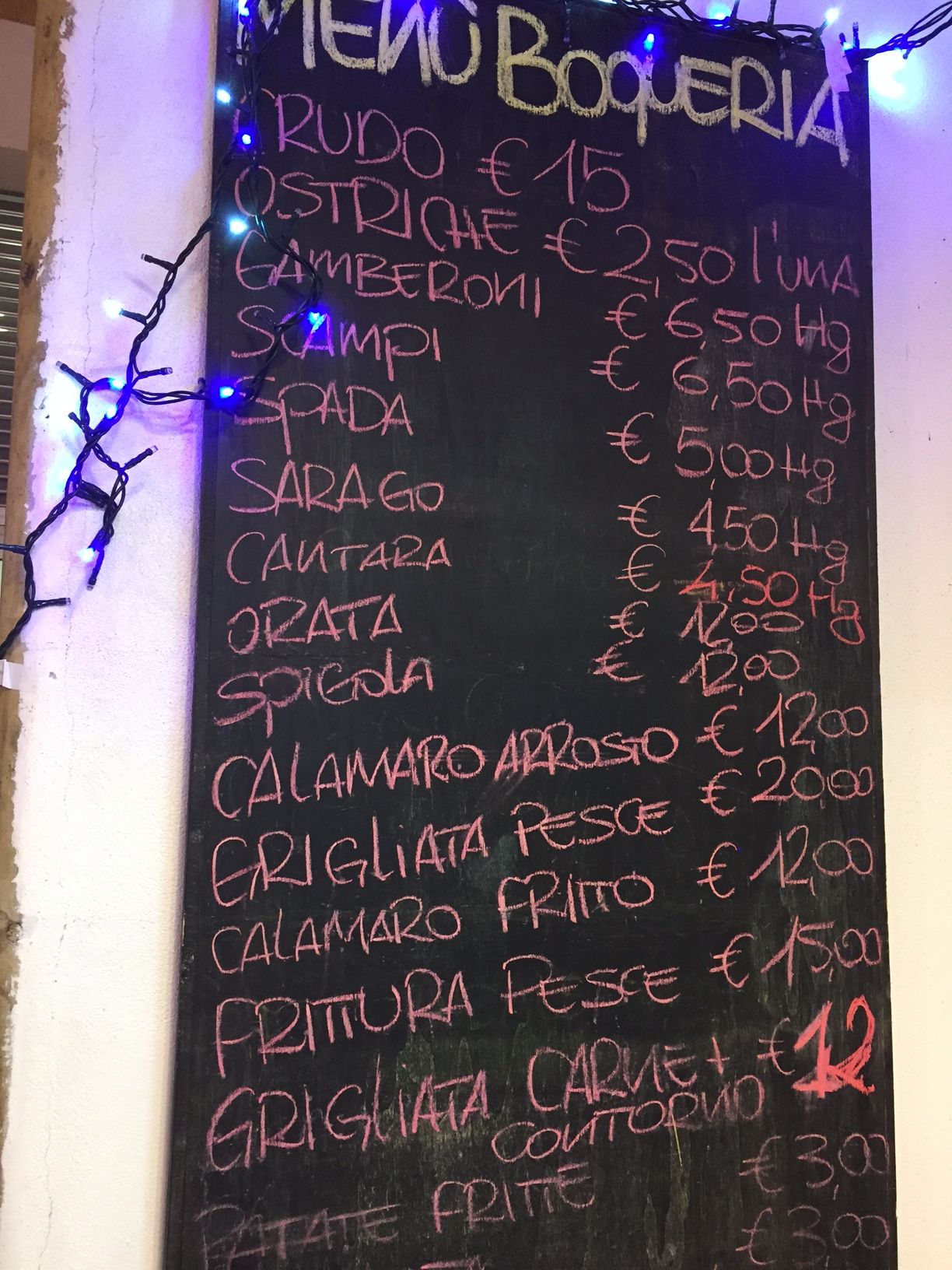
The fishmongers’ stalls were
already being washed down, having sold all the
seafood brought in early that morning. But on
the premises is a tiny trattoria with a blackboard
menu of the day’s offerings, and by the end of
this midday meal, I felt as happy and effervescent
as the bubbles in the wine.
I was there with
representatives of Cantina
Santa Maria La Palma, composed of 326
growers who contribute their grapes to Sardinia’s
most modern winery, just outside of the seaside
city of Alghero.
The Akènta sparkling wine is made by the
Charmat method, aged six months on the yeasts,
making for bracing freshness with plenty of fruit
and flower flavors that went so perfectly with my
extravagant, if humble, seafood lunch.
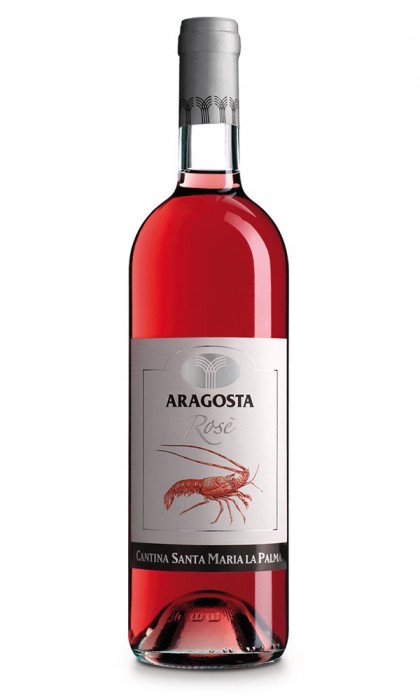 Over
the
next two days I was to learn much more—and eat
much more—that brought me up to speed on
contemporary winemaking in Sardinia, now, as in
Sicily, building its reputation on cantinas and
co-operatives rather than individual wineries. It
is believed the Phoenicians brought wine grapes to
the island and that the Spanish might have
introduced the Vermentino grape, now planted all
over the island.
(In France the varietal is called rolle.)
Over
the
next two days I was to learn much more—and eat
much more—that brought me up to speed on
contemporary winemaking in Sardinia, now, as in
Sicily, building its reputation on cantinas and
co-operatives rather than individual wineries. It
is believed the Phoenicians brought wine grapes to
the island and that the Spanish might have
introduced the Vermentino grape, now planted all
over the island.
(In France the varietal is called rolle.)
Cantina Santa Maria La Palma
prides itself on its rustic roots and its “humble
winemakers, [who] rather than a silver spoon, had
strong arms, straight backs, passion and
commitment.”
Today the company produces an array of red
and white wines that are remarkable for the
vibrancy and depth they have, even when released
so soon after they are made from the latest
vintage.
Founded in 1959, at a time when
Sardinian wines had no reputation and little
availability outside the island, Cantina Santa
Maria La Palma realized that by central control of
co-operative growers, the wines could be made
better and with more consistency, fresher, less
prone to oxidation, and at price points that have
made them appealing in a global market flooded
with bland varietals.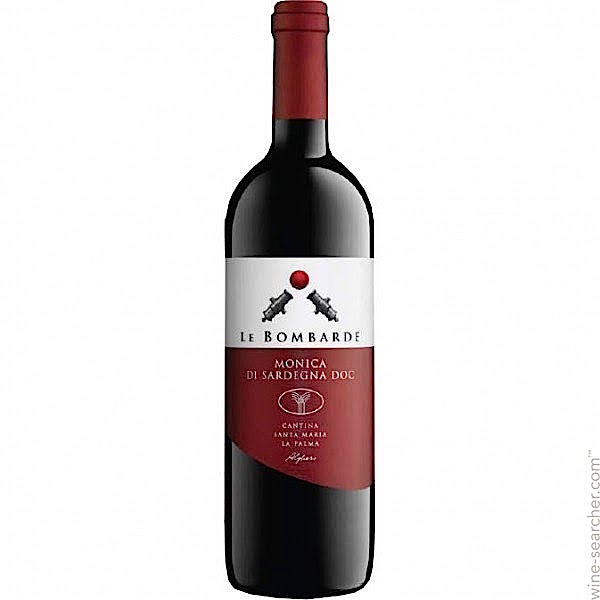
Sardinia, south of France and
west of Italy, has a very hot, very dry
land, so irrigation of the vineyards is allowed;
you taste the flintiness of the soil and the
brininess of the surrounding Tyrrhenian Sea. One of Santa
Maria's wines, Akènta
Sub, is actually lowered into the sea
for a while to age (below).
Under the Aragosta
(“lobster”) label Santa Maria produces a bright
DOC Vermentino
di Sardegna ($11.99) intended to be drunk as soon
after bottling as possible, so I was actually
enjoying a 2015 in the middle of December, with a
delightful 12 percent alcohol. It is in fact
Italy’s most popular bottled DOC white wine,
selling 1.5 million bottles out of Santa Maria’s
total 4-million-bottle annual production of all
wines. There is also a good rosé ($10.99) under
the Aragosta line that I enjoyed with cured meats
and pecorino cheeses.
Vermentino
Blu is made from the same grape, a
lovely, creamy wine, very silky, a perfect match
with grilled prawns. Papiri is
their top-of-the-line Vermentino, made with
handpicked grapes from specially selected old
vines. The
2014, with 13 percent alcohol, is a formidable
white wine that I’d put up against the very best
whites in Italy right now.
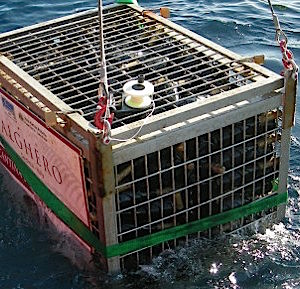 The
company’s red wines share the notion that youth,
not long aging, has its own charms, depending on
the grape. In
Sardinia, the most significant red grape is Cannonau di
Sardegna, DOC produced near the towns of
Maristella and Guardia Grande, where the sandy
soil is calcium-rich, with ferrous clay, making
for a very earthy wine, but also one with several
layers of fruit, acid, and mineral flavors. Santa
Maria’s Riserva 2012
is a big red, though with only 13.5 percent
alcohol, neither overbearing nor harsh. Instead,
it is velvety on the palate and an ideal wine to
go with the Sardinian roast suckling pig called porceddu.
The
company’s red wines share the notion that youth,
not long aging, has its own charms, depending on
the grape. In
Sardinia, the most significant red grape is Cannonau di
Sardegna, DOC produced near the towns of
Maristella and Guardia Grande, where the sandy
soil is calcium-rich, with ferrous clay, making
for a very earthy wine, but also one with several
layers of fruit, acid, and mineral flavors. Santa
Maria’s Riserva 2012
is a big red, though with only 13.5 percent
alcohol, neither overbearing nor harsh. Instead,
it is velvety on the palate and an ideal wine to
go with the Sardinian roast suckling pig called porceddu.
Cagnulari
2014 is made from a native grape, which some
believe was exported to Spain to be part of the
blend of Rioja, while Le Bombarde
2014 ($13.99), made from Monica di Sardinia
grapes, has the most pronounced fruit flavors,
particularly of cherries. The label depicts old
cannons, symbolizing the many times Sardinia had
to defend itself from invaders.
❖❖❖

EXCUSE ME, MA'AM. BUT JUST HOW MANY LOAVES
OF BREAD DID YOU CONSUME TONIGHT?
FOOD WRITING 101: TRY NOT TO USE
MORE 
THAN 10 POP CULTURE REFERENCES
IN ONE PARAGRAPH
“If
you’ve spent any time in London lately, you’ve
probably noticed that there’s something happening with
the restaurant scene over there. Call it a re-birth,
call it gentrification, or call it Brooklynization
(actually don’t call it that), but there is definitely
a new crop of interesting, youthful, excellent
restaurants popping up around that city. A city, mind
you, whose most significant recent contributions to
the US food scene have been Gordon Ramsay and allowing
Kate Middleton to be seen at a McDonald's once.
Thanks, England.’—Chris Stang, “The Clocktower,”
Infatuation (10/15)
Any of John Mariani's books below may be ordered from amazon.com.
 I'm proud and happy to announce that my
new book, The Hound
in Heaven (21st Century Lion Books), has just
been published through Amazon and Kindle.
I'm proud and happy to announce that my
new book, The Hound
in Heaven (21st Century Lion Books), has just
been published through Amazon and Kindle. It is a novella, and for anyone who loves dogs, Christmas, romance, inspiration, even the supernatural, I hope you'll find this to be a treasured favorite. The story concerns how, after a New England teacher, his wife and their two daughters adopt a stray puppy found in their barn in northern Maine, their lives seem full of promise. But when tragedy strikes, their wonderful dog Lazarus and the spirit of Christmas are the only things that may bring back his master back from the edge of despair.
WATCH THE VIDEO!
“What a huge surprise turn this story took! I was completely stunned! I truly enjoyed this book and its message.” – Actress Ali MacGraw
“He had me at Page One. The amount of heart, human insight, soul searching, and deft literary strength that John Mariani pours into this airtight novella is vertigo-inducing. Perhaps ‘wow’ would be the best comment.” – James Dalessandro, author of Bohemian Heart and 1906.
“John Mariani’s Hound in Heaven starts with a well-painted portrayal of an American family, along with the requisite dog. A surprise event flips the action of the novel and captures us for a voyage leading to a hopeful and heart-warming message. A page turning, one sitting read, it’s the perfect antidote for the winter and promotion of holiday celebration.” – Ann Pearlman, author of The Christmas Cookie Club and A Gift for my Sister.
“John Mariani’s concise, achingly beautiful novella pulls a literary rabbit out of a hat – a mash-up of the cosmic and the intimate, the tragic and the heart-warming – a Christmas tale for all ages, and all faiths. Read it to your children, read it to yourself… but read it. Early and often. Highly recommended.” – Jay Bonansinga, New York Times bestselling author of Pinkerton’s War, The Sinking of The Eastland, and The Walking Dead: The Road To Woodbury.
“Amazing things happen when you open your heart to an animal. The Hound in Heaven delivers a powerful story of healing that is forged in the spiritual relationship between a man and his best friend. The book brings a message of hope that can enrich our images of family, love, and loss.” – Dr. Barbara Royal, author of The Royal Treatment.
 |
The Encyclopedia of American Food and Drink by John F. Mariani (Bloomsbury USA, $35) Modesty forbids me to praise my own new book, but let me proudly say that it is an extensive revision of the 4th edition that appeared more than a decade ago, before locavores, molecular cuisine, modernist cuisine, the Food Network and so much more, now included. Word origins have been completely updated, as have per capita consumption and production stats. Most important, for the first time since publication in the 1980s, the book includes more than 100 biographies of Americans who have changed the way we cook, eat and drink -- from Fannie Farmer and Julia Child to Robert Mondavi and Thomas Keller. "This book is amazing! It has entries for everything from `abalone' to `zwieback,' plus more than 500 recipes for classic American dishes and drinks."--Devra First, The Boston Globe. "Much needed in any kitchen library."--Bon Appetit. |
"Eating Italian will never be the same after reading John Mariani's entertaining and savory gastronomical history of the cuisine of Italy and how it won over appetites worldwide. . . . This book is such a tasteful narrative that it will literally make you hungry for Italian food and arouse your appetite for gastronomical history."--Don Oldenburg, USA Today. "Italian
restaurants--some good, some glitzy--far
outnumber their French rivals. Many of
these establishments are zestfully described
in How Italian Food Conquered the World, an
entertaining and fact-filled chronicle by
food-and-wine correspondent John F.
Mariani."--Aram Bakshian Jr., Wall Street
Journal.
"Equal parts
history, sociology, gastronomy, and just
plain fun, How Italian Food Conquered the
World tells the captivating and delicious
story of the (let's face it) everybody's
favorite cuisine with clarity, verve and
more than one surprise."--Colman Andrews,
editorial director of The Daily
Meal.com. "A fantastic and fascinating
read, covering everything from the influence
of Venice's spice trade to the impact of
Italian immigrants in America and the
evolution of alta cucina. This book will
serve as a terrific resource to anyone
interested in the real story of Italian
food."--Mary Ann Esposito, host of PBS-TV's
Ciao
Italia. "John Mariani has written the
definitive history of how Italians won their
way into our hearts, minds, and
stomachs. It's a story of pleasure over
pomp and taste over technique."--Danny Meyer,
owner of NYC restaurants Union Square
Cafe, The Modern, and Maialino.
|
 |
 |
 |
 |
 |
 |
 |
 |
 Everett Potter's Travel Report:
Everett Potter's Travel Report: 
 Eating Las
Vegas JOHN CURTAS has been covering
the Las Vegas food and restaurant scene
since 1995. He is the co-author of EATING LAS
VEGAS – The 50 Essential Restaurants (the
fourth edition of which will be published in
early 2016), as well as the author of the Eating Las
Vegas web site: www.eatinglasvegas.
He can also be seen every Friday morning as
the “resident foodie” for Wake Up With the
Wagners on KSNV TV (NBC) Channel 3 in
Las Vegas.
Eating Las
Vegas JOHN CURTAS has been covering
the Las Vegas food and restaurant scene
since 1995. He is the co-author of EATING LAS
VEGAS – The 50 Essential Restaurants (the
fourth edition of which will be published in
early 2016), as well as the author of the Eating Las
Vegas web site: www.eatinglasvegas.
He can also be seen every Friday morning as
the “resident foodie” for Wake Up With the
Wagners on KSNV TV (NBC) Channel 3 in
Las Vegas.

Tennis Resorts Online: A Critical Guide to the World's Best Tennis Resorts and Tennis Camps, published by ROGER COX, who has spent more than two decades writing about tennis travel, including a 17-year stretch for Tennis magazine. He has also written for Arthur Frommer's Budget Travel, New York Magazine, Travel & Leisure, Esquire, Money, USTA Magazine, Men's Journal, and The Robb Report. He has authored two books-The World's Best Tennis Vacations (Stephen Greene Press/Viking Penguin, 1990) and The Best Places to Stay in the Rockies (Houghton Mifflin, 1992 & 1994), and the Melbourne (Australia) chapter to the Wall Street Journal Business Guide to Cities of the Pacific Rim (Fodor's Travel Guides, 1991).


MARIANI'S VIRTUAL GOURMET
NEWSLETTER is published weekly. Editor/Publisher: John
Mariani.
Editor: Walter Bagley. Contributing Writers: Christopher Mariani,
Robert Mariani, Misha
Mariani,
John A. Curtas, Edward Brivio, Mort Hochstein,
Andrew Chalk, Dotty Griffith and Brian Freedman. Contributing
Photographers: Galina Dargery, Bobby
Pirillo. Technical Advisor: Gerry McLoughlin.
To un-subscribe from this newsletter,click here.
© copyright John Mariani 2016

